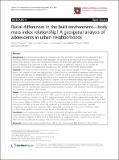| dc.contributor.author | Duncan, Dustin T | |
| dc.contributor.author | Castro, Marcia C.de | |
| dc.contributor.author | Gortmaker, Steven L. | |
| dc.contributor.author | Aldstadt, Jared | |
| dc.contributor.author | Melly, Steven John | |
| dc.contributor.author | Bennett, Gary G | |
| dc.date.accessioned | 2013-04-23T18:00:20Z | |
| dc.date.issued | 2012 | |
| dc.identifier.citation | Duncan, Dustin T, Marcia C Castro, Steven L Gortmaker, Jared Aldstadt, Steven J Melly, and Gary G Bennett. 2012. Racial differences in the built environment—body mass index relationship? A geospatial analysis of adolescents in urban neighborhoods. International Journal of Health Geographics 11:11. | en_US |
| dc.identifier.issn | 1476-072X | en_US |
| dc.identifier.uri | http://nrs.harvard.edu/urn-3:HUL.InstRepos:10579573 | |
| dc.description.abstract | Background: Built environment features of neighborhoods may be related to obesity among adolescents and potentially related to obesity-related health disparities. The purpose of this study was to investigate spatial relationships between various built environment features and body mass index (BMI) z-score among adolescents, and to investigate if race/ethnicity modifies these relationships. A secondary objective was to evaluate the sensitivity of findings to the spatial scale of analysis (i.e. 400- and 800-meter street network buffers). Methods: Data come from the 2008 Boston Youth Survey, a school-based sample of public high school students in Boston, MA. Analyses include data collected from students who had georeferenced residential information and complete and valid data to compute BMI z-score (n = 1,034). We built a spatial database using GIS with various features related to access to walking destinations and to community design. Spatial autocorrelation in key study variables was calculated with the Global Moran’s I statistic. We fit conventional ordinary least squares (OLS) regression and spatial simultaneous autoregressive error models that control for the spatial autocorrelation in the data as appropriate. Models were conducted using the total sample of adolescents as well as including an interaction term for race/ethnicity, adjusting for several potential individual- and neighborhood-level confounders and clustering of students within schools. Results: We found significant positive spatial autocorrelation in the built environment features examined (Global Moran’s I most ≥ 0.60; all p = 0.001) but not in BMI z-score (Global Moran’s I = 0.07, p = 0.28). Because we found significant spatial autocorrelation in our OLS regression residuals, we fit spatial autoregressive models. Most built environment features were not associated with BMI z-score. Density of bus stops was associated with a higher BMI z-score among Whites (Coefficient: 0.029, p < 0.05). The interaction term for Asians in the association between retail destinations and BMI z-score was statistically significant and indicated an inverse association. Sidewalk completeness was significantly associated with a higher BMI z-score for the total sample (Coefficient: 0.010, p < 0.05). These significant associations were found for the 800-meter buffer. Conclusion: Some relationships between the built environment and adolescent BMI z-score were in the unexpected direction. Our findings overall suggest that the built environment does not explain a large proportion of the variation in adolescent BMI z-score or racial disparities in adolescent obesity. However, there are some differences by race/ethnicity that require further research among adolescents. | en_US |
| dc.language.iso | en_US | en_US |
| dc.publisher | BioMed Central | en_US |
| dc.relation.isversionof | doi:10.1186/1476-072X-11-11 | en_US |
| dc.relation.hasversion | http://www.ncbi.nlm.nih.gov/pmc/articles/PMC3488969/pdf/ | en_US |
| dash.license | LAA | |
| dc.subject | Spatial epidemiology | en_US |
| dc.subject | Neighborhood effects | en_US |
| dc.subject | Built environment | en_US |
| dc.subject | BMI | en_US |
| dc.subject | Adolescents | en_US |
| dc.subject | Race effects | en_US |
| dc.title | Racial differences in the built environment—body mass index relationship? A geospatial analysis of adolescents in urban neighborhoods | en_US |
| dc.type | Journal Article | en_US |
| dc.description.version | Version of Record | en_US |
| dc.relation.journal | International Journal of Health Geographics | en_US |
| dash.depositing.author | Castro, Marcia C.de | |
| dc.date.available | 2013-04-23T18:00:20Z | |
| dc.identifier.doi | 10.1186/1476-072X-11-11 | * |
| dash.contributor.affiliated | Duncan, Dustin T. | |
| dash.contributor.affiliated | Gortmaker, Steven | |
| dash.contributor.affiliated | Castro, Marcia | |
| dash.contributor.affiliated | Melly, Steven | |


